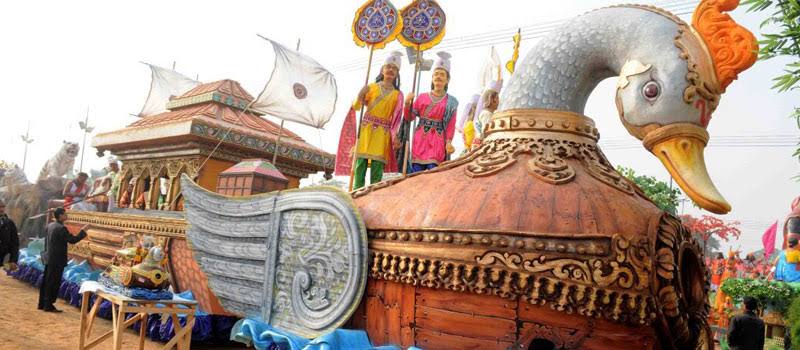Remembering the kalinga sadhaba merchants
Maritime history of odisa known as kalinga in ancient time started much before 800 B C.The Bay of Bengal known as kalinga sagar indicating the importance of Kalinga during in the maritime trade. The ancient state of kalinga extended from the Ganges to Godavari River. The navigable rivers including the Ganges, Mahanadi, Vasundhara and Godavari where their deltas provided natural harbours.

There are two types of ports in Early Odisha.. The categorisation was made on the basis of the location. They are
Pattana where ports were situated on the sea coast where cargos were loaded and unloaded. Dronimukha were the ports situated near the confluence of the river and sea.some of the ports mentioned by Ptolemy in the 2nd centuary AD were Nanigaina, katikardama, and kannagara.. The important ports on kalinga coastline were Tamralipta, khakatapatna, Manikpatna, palur, Gopalpur, Dosarene, Sonapur, Baruva, kalingapatnam, Pithuda. Later in 9th and 10th centuaries CE, Ganjam, Kalinganagar, Keylkari,. etc. After 15th centuary ports included Balasore, Pipli, Ganjam, Harishpur, Chandabali and Dharma.
Rules and regulations regarding the construction of ships were recorded in sanskrit Juktikalpataru.
It says there are two type of ships being made one river going vessels and other is sea going vessels. For the construction of ships four kinds od woods were distinguished.
Branhmajati this group consists of wood that is light and soft and can easily be joined to anyother kind of wood.
kshetrahati the wood is light and hard but cannot be joined to other woods.
Sudrajati the wood is charaterised by both hardnessand heaviness.
Vaisyajati the wood is soft and heavy.
Dvijiti the wood is of mixed variety which has blended properties of two seperate groups.
It says that no iron was used only wood was used for making of sea going vessels. Here the hulls were stitched together with a rope rather than nailed across a frame.
Ships were classified into two groups river going samanya and sea going vessels called visesa..Ships have been divided into ten class Ksudra, madhyama, bhima, capala, patala, bhaya, dirgha, patraputa, garbhara, manthara. Sea going special ships Dirgha & unnata.
Dirgha has further divided into dirghika, tarani, iola, gatvara, gamini, tari, janghala, plavini, dharini, vegini.
Unnata has also varities Udhava, anurddhava, svarnarmukhi, garbini, manthara. Gold, silver, copper and compound of all above three were used for decoration of ship.The prows of the ships were also decorated with great variety of fanciful shapes and forms like the heads of lion, buffalo, serpent, elephant, tiger, birds, such as duck, peahen, or parrot, frog and human.. After painting the ship with the respective colour with regards to the mast, the body of of the ship is then painted with pictures of celestial bodies such as sun moon etc deities, swan peacock lion, elephant tiger etc.
India has two types of monsoon winds one is India has two distinct monsoon wind types. The North-East monsoon, also known as the retreating monsoon blows from November through December, when the wind direction is extremely good for travelling up to Sri Lanka from any East Coast coast. During this time, the Bay of Bengal largely remains calm. Therefore, Sadhabas used to set out on their journey during the auspicious time of Kartika Purnima.
The South-West monsoon blows during the period from June to September. The wind direction of this period is quite favourable for the return journey from Sri Lanka to any port of Kalinga. Festivals associated with the return journey of the Sadhabas like Khudurukuni Osha, is a testament of how the Monsoon winds were leveraged to their benefit, by the Sadhabas.
According to 6th Century AD kalinga was famous its elephants for which it had a market in Cyelon along with precious stones, ivory, pepper, betelnuts, and fine textiles. In return kalinga sadhavas imported precious stones, ivory, pepper, betel nuts and fine textiles. Kalinga imported pearl and silver from ceylon. Corn and rice were also exported. Traders imported spices and sandalwood from sea.
The dominance of the Kalingas over the sea routes can be understood from the fact that Kalidasa in his Raghuvamsa referred to the King of Kalinga as ‘The Lord of the Sea’. Odia traders were overshadowed by the Arab trader after 13th and 14th century and the overseas.
The maritime relation of kalinga had left its strongest impact in countries like Srilanka, Mynamar Indonesia, Malaysia and Thialand.Hindu culture of state of Bali in Indonesia has great similirity.
In odisa we remember the Sadabhavs by celebrating the boita bandhan at various rivers, sea by sailing a paper boat saying ‘Aa kaa ma boi paan gua thoi “. The famous Baliyatra is being celebrated remembering the brave sadhavs.
Sasmita patro
Dr sanjay patro
Dean XLRI
Jamsedpur
9032816528

